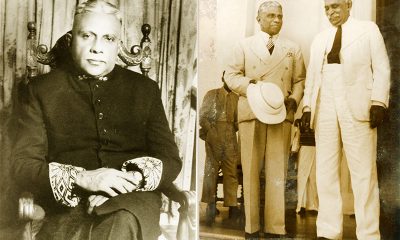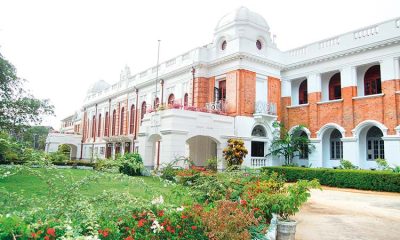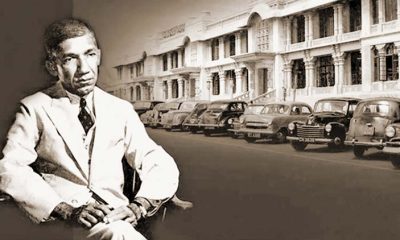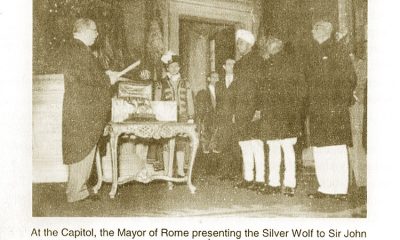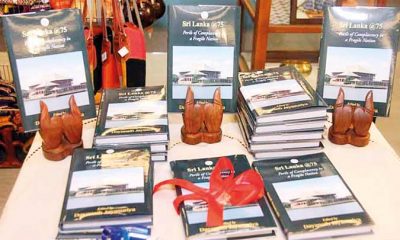Features
D. R Wijewardene 1886-1950, newspaper baron and all time great in the struggle for Independence

CHIEFS AND FRIENDS
(Excerpted from Selected Journalism by HAJ Hulugalle)
Don Richard Wijewardene was one of the formative influences of our times. Had he died in his early youth, the history of Ceylon during the past 30 years might well have been different. He was not merely a powerful newspaper proprietor, though to be one was a considerable achievement as never before had a Ceylonese succeeded in establishing a newspaper on a sound business foundation.
Lorenz tried with the “Examiner.” Hector Van Cuylenberg with the “Independent,” the de Soysa family with the “Standard” and the “Morning Leader” and Sir P. Ramanathan and the Jayewardene brothers with the “Ceylonese.” Each of them had some measure of success but none on the same scale and of the duration of Wijewardene’s great enterprise.
D. R. Wijewardene was first and last a patriot. It was the love of his country which led him to prepare, as a student in England, for his life’s work. It was his realization that the struggle for independence was the one most worthy of a wealthy young man’s energies that guided him to politics. Although he possessed a strong personality he had not sufficient confidence in his ability to excel in debate or sway crowds by power of speech. He chose the far more effective method of influencing men by establishing newspapers, among the best in Asia and published in the national languages as well as in English.
He was the third son in a family of nine and was born at Sedawatte, where his father, the late Muhandiram D.P. Wijewardene, a wealthy merchant and contractor, lived within easy reach of Colombo, where he had a very successful business. Richard Wijewardene was educated at St. Thomas’ College when Read was Warden and the Rev. G. A. H. Arndt was Sub-Warden. His teachers included Swinburne, Meynert, J. S. H. Edirisinghe, C V_ Pereira and E. Navaratnam. Among his contemporaries were D. S. Senanayake and Francis Molamure.
From St. Thomas’, Wejewardene went to Peterhouse, Cambridge. He has told us that it was in his undergraduate days at Cambridge that his interest in politics began. “There was a wave of unrest in India, as a result of Lord Curzon’s action in partitioning Bengal, and prominent Indian leaders came over to England and addressed meetings to enlighten the British public on the situation in their country.
Among them there was Lala Lajpat Rai, a great nationalist and scholar, who had been deported under an obsolete law. Bepin Chandra Pal and Surendranath Banerji, generally known as the silver-tongued orator of Bengal, drew large audiences.
There came to England also Mr. Gopal Krishna Gokhale, a member of the Imperial Legislative Council, a statesman who made great sacrifices in the service of his country. He impressed on me that every educated young man, Indian or Ceylonese, had a part to play in the public life of his country and must be prepared to make sacrifices for his country’s welfare.
I met Gokhale often at the National Liberal Club and had many long and interesting talks with him on political questions of the day. He asked me to accompany him on his great mission to South Africa as one of his secretaries. To my great regret I was not able to accept the invitation.”
Wijewardene’s friend and mentor during his student life in England was F. H. M. Corbet, an influential barrister with Ceylon connections. Among those who worked in Corbet’s chambers at the time, and whom Wijewardene met frequently, were Patrick Hastings, later to become Attorney-General of England and Brooke Eliott, who practised in Ceylon and Madras. Corbet had many friends in the House of Commons and showed him the ropes “in the delicate task of interesting Members of Parliament in the domestic affairs of a Crown Colony.”
Wijewardene organized the first Reforms deputation to be received by Colonel Seely (afterwards Lord Mottistone) on behalf of the Secretary of State for the Colonies, the Marquis of Crewe. The deputation was led by Mr. H. J. C. Pereira K. C., and included Mr. E.W. Perera. Wijewardene organized a second deputation two years later, this time to meet Mr. Lewis Harcourt, the Secretary of State. He induced Sir Baron Jayatilaka and Sir Marcus Fernando to join it.
On his return to the Island from the exhilarating atmosphere of British politics, Wijewardene found local conflicts distinctly parochial. He was not interested in a career at the Bar, but to Hultsdorp he went because it was there that all political movements were set afoot. Ponnambalam Ramanathan and James Peiris had retired from the Bar but H. J. C. Pereira, Hector Jayewardene, E.J. Samarawickrame, Francis de Zoysa, R. L. Pereira, E. W. Perera, D. B. Jayatilaka, and younger men like E. T. de Silva and M. A. Arulanandam, were knocking at the door of the political arena. But there was only one seat in the legislature to which they could have aspired, the so called Educated Ceylonese Seat, to which Sir Ponnambalam Ramanathan had been elected.
The riots in 1915 were suppressed in a brutal manner and political agitation was prohibited by a strict censorship. As soon as this was relaxed D. R. Wijewardene, who had resigned his commission in the Ceylon Light Infantry, re-organized the Ceylon National Association. He persuaded Sir Ponnambalam Arunachalam who had retired from the Civil Service to deliver an address on “Our Political Needs.
” The outcome of this was the formation of the Ceylon Reform League, formed for the purpose of putting forward the case for a substantial measure of responsible government for Ceylon. D. R. Wijewardene was joint Secretary of the League with W. A. de Silva. The Ceylon National Congress was formed the next year under the presidentship of Sir P. Arunachalam.
Wijewardene also helped Arunachalam and James Peiris to organize the Ceylon Social Service League and was one of its joint secretaries. He had so impressed the older politicians by his remarkable grasp of current affairs and organizing capacity that he was always in the inner councils of the Reform movement. On one occasion Sir Ponnambalam Arunachalam wound up his presidential address to the National Congress with a tribute to Mr. Wijewardene who, he said, always worked quietly “like a process of nature.”
D. R. Wijewardene’s major contribution was the moulding of public opinion through the highly successful newspapers he conducted. Their success was due not only to business ability and political knowledge but even in greater measure to a flair for journalism. Although he had never been a reporter or political correspondent he was always the best news-gatherer of his papers. Though he very rarely put pen to paper, the columnists and leader-writers were inspired and encouraged by his uncanny gift of reading the public mind. One of his staff would sometimes feel that the public would not stand for the line taken by him on some controversial issue but “The Chief’ was usually proved correct.
D. R. Wijewardene’s interest in journalism was stimulated by daily reading of the London “Daily News” then edited by A. G. Gardiner. Among the regular contributors to that paper were Arnold Bennet, G. K. Chesterton, Spencer Leigh Hughes and Charles Masterman. When he founded a newspaper himself, Wijewardene called it the “Ceylon Daily News.” In the meantime he owned a half share in a Sinhalese newspaper called the “Dinamina” published from Norris Road in which D. B. (later Sir Baron) Jayatilaka wrote most of the editorials.
The “Ceylon Daily News” was and remains the keystone of the edifice which Wijewardene built up. Writing on its twenty-fifth birthday, the late Orion de Zylva, one of its brilliant staff, wrote:
“When the ‘Daily News’ was published on January 3, 1918, certain ideals were aimed at. To turn these ideals into a deed required in the doer a spirit of determination and high adventure.
“The way of Ceylonese journalism up to that time was for the most part crazy-paved with broken fortunes and shattered hopes. To make the prospect even more discouraging the “Ceylonese,” launched a few years earlier by a group of able and patriotic men with a confidence sustained by hope, had only recently failed. But Mr. Wijewardene was not deterred by these unhappy omens. Purchasing the plant and machinery of the “Ceylonese” and engaging the services of some of its staff and other competent assistants he boldly started the enterprise he had planned and which his powers of organization were to develop into a mighty force for the country’s good.
“In achieving this, he proved that any person possessed of perseverance and drive and fired by an intense desire to attain an ideal could not only command success in business but that he could make a success of a business of the most intricate and complicated kind involved in the running of several newspapers.
“To Mr. Wijewardene’s everlasting credit let it be remembered that he dared and executed what was nothing less than a constructive revolution in journalism such as it had been up to the time he entered the field. The “Daily News” was to be a newspaper with a soul. Though with convictions and opinions of its own, it was to give a fair show always to other convictions and opinions. It was meant to appeal to all thoughtful men and women anxious for the country’s welfare and advancement irrespective of race or creed.”
D. R. Wijewardene bought the assets of the “Ceylonese” for Rs. 20,000. He bought the “Ceylon Observer” and Ferguson’s Directory for a lakh and twenty thousand rupees from a syndicate financed by the late W. H. Figg and representing the European Association.
He leaves a group of half a dozen newspapers, in a palatial home equipped as well as any newspaper organization in the East and giving to the readers daily in all the languages of the country “all the news that’s fit toprint,” independent views, a valuable medium of culture and an indispensable arena of public debate. For 30 years he gave himself up fiercely and wholeheartedly to the exacting business of conducting these journals.
At the start there were many financial and other problems. The “Daily News”first came to life under the shadow of a war censorship. Paper was difficult to get and shipments were uncertain owing to the German submarine campaign. There were already two other English morning newspapers in the field and the editor of one of them, the late Armand de Souza, a redoubtable journalist, was then in his prime. Wijewardene took the bold step of cutting the price of the “Daily News” to five cents when the rival papers were charging ten cents.
The older proprietors and editors did not encourage special articles from outside contributors. Wijewardene did so. Leading men in every walk of life took pride and pleasure in writing for the paper. Contracts were made with well-known English publicists fora regular flow of articles into its columns. Reuters were pressed and paid to improve their services and the London office of the paper was strengthened both from the business and editorial angles. Sir Baron Jayatilaka introduced Frederick Grubb who became London correspondent for 15 years.
Development of the newspaper enterprise meant investment of large sums of money. There was no Bank of Ceylon then and some of the European banks would not lend without the guarantee of a shroff. Wijewardene had often to mortgage his private property to finance the business. The Associated Newspapers of Ceylon Limited, was incorporated after the “Observer” was purchased and the new building was put up at a cost of two lakhs – nowadays a trifling sum – raised by a debenture issue. There were anxious times as during the great depression when advertising revenue sank to small proportions.
Wijewardene was a good judge of men and did not, unfortunately, suffer fools gladly. This and his success sometimes gave him a reputation for arrogance. But it was his natural shyness and dislike of the limelight which made him something of a man of mystery, a “dens ex machine.” He always had loyal workers, men who were ready to be driven hard because they respected his integrity and devotion to duty.
S.J.K. Crowther, whom he had known in England, joined him in 1919 as editor of the “Daily News” and continued in that position until 1931. The partnership was a happy and fruitful one and helped to lay the solid foundations on which the paper stands. But no man worked harder than Wijewardene himself. Even after he bought his delightful house in Diyatalawa he found little time for relaxation and those who went up with him for the week-end were always aware that he had not left his worries behind.
His cares and anxieties were of various kinds and he seemed to enjoy them as some people enjoy a drug. He was always bothered about public affairs and kept in touch with them by telephoning his few political friends. He was a student all his life and was constantly digging into official publications to discover subjects for editorials. He had a habit of extracting information about various matters from persons he met at weddings, funerals or in the course of his walks round Victoria Park. Whatever the question under public controversy, he had a reliable informant who gave him the background.
He was sometimes misinformed, but was never afraid to form an independent opinion regardless of personal relationships. Part of the reasons for the life of a recluse he led was that he tried to be free from influences which might sway him from the path of duty as a newspaper man. As a politician he had been brought up as a liberal with strong radical leanings, and this he remained to the last. When Ceylon got her independence the Prime Minister paid a well-deserved tribute to him as one of the architects of the country’s freedom.
Wijewardene was incapable of disconnecting from the switchboard of a newspaper’s ramifications. He would sometimes get up from the dinner table and go to the telephone to make a suggestion to an editor or to inquire from a sub-editor whether an important speech in the legislature had been adequately reported. He was an exceptionally able businessman and gave the major part of his working hours to the dull details of the counting house but his chief interest in journalism was news and the moulding of opinion.
For a conscientious proprietor a newspaper is not an understanding spouse but a jealous mistress. Lord Beaverbrook, who did not work half as hard as Wijewardene has written: “The business of producing a newspaper requires a type of mind which is very rare indeed. You Must he ready to put your whole heart and soul, your stomach, your liver, your whole anatomy, into a task which will appear most of the time to be dangerously stimulating and occasionally positively revolting.” (Millionaires and their Newspapers – Humbug and Ignorance)
It is not Lake House that will be a monument to the life of D.R. Wijewardene. The enduring monument will be his contribution to the building of the nation. He was not a man without faults. He was not often prepared to see the other side of a question. He was not always tolerant. He was frequently too preoccupied with his own problems to give a thought to the problems of even his nearest colleagues.
He relaxed so rarely that he had almost driven laughter out of his life until his health broke down and he was compelled to abandon his work. But at heart he was a kindly man. It is possible that he regretted nothing more in his later years than the hours he stole from his home and his friends and sacrificed to his business. He loved books, pictures, trees and flowers, but he denied himself of the pleasures they give. There is no respite for mortal creatures. Even a noble achievement must be paid for. By the death of D. R. Wijewardene, six years short of the Psalmist’s span, Ceylon loses one of its few great men.
Features
The heart-friendly health minister

by Dr Gotabhya Ranasinghe
Senior Consultant Cardiologist
National Hospital Sri Lanka
When we sought a meeting with Hon Dr. Ramesh Pathirana, Minister of Health, he graciously cleared his busy schedule to accommodate us. Renowned for his attentive listening and deep understanding, Minister Pathirana is dedicated to advancing the health sector. His openness and transparency exemplify the qualities of an exemplary politician and minister.
Dr. Palitha Mahipala, the current Health Secretary, demonstrates both commendable enthusiasm and unwavering support. This combination of attributes makes him a highly compatible colleague for the esteemed Minister of Health.
Our discussion centered on a project that has been in the works for the past 30 years, one that no other minister had managed to advance.
Minister Pathirana, however, recognized the project’s significance and its potential to revolutionize care for heart patients.
The project involves the construction of a state-of-the-art facility at the premises of the National Hospital Colombo. The project’s location within the premises of the National Hospital underscores its importance and relevance to the healthcare infrastructure of the nation.
This facility will include a cardiology building and a tertiary care center, equipped with the latest technology to handle and treat all types of heart-related conditions and surgeries.
Securing funding was a major milestone for this initiative. Minister Pathirana successfully obtained approval for a $40 billion loan from the Asian Development Bank. With the funding in place, the foundation stone is scheduled to be laid in September this year, and construction will begin in January 2025.
This project guarantees a consistent and uninterrupted supply of stents and related medications for heart patients. As a result, patients will have timely access to essential medical supplies during their treatment and recovery. By securing these critical resources, the project aims to enhance patient outcomes, minimize treatment delays, and maintain the highest standards of cardiac care.
Upon its fruition, this monumental building will serve as a beacon of hope and healing, symbolizing the unwavering dedication to improving patient outcomes and fostering a healthier society.We anticipate a future marked by significant progress and positive outcomes in Sri Lanka’s cardiovascular treatment landscape within the foreseeable timeframe.
Features
A LOVING TRIBUTE TO JESUIT FR. ALOYSIUS PIERIS ON HIS 90th BIRTHDAY

by Fr. Emmanuel Fernando, OMI
Jesuit Fr. Aloysius Pieris (affectionately called Fr. Aloy) celebrated his 90th birthday on April 9, 2024 and I, as the editor of our Oblate Journal, THE MISSIONARY OBLATE had gone to press by that time. Immediately I decided to publish an article, appreciating the untiring selfless services he continues to offer for inter-Faith dialogue, the renewal of the Catholic Church, his concern for the poor and the suffering Sri Lankan masses and to me, the present writer.
It was in 1988, when I was appointed Director of the Oblate Scholastics at Ampitiya by the then Oblate Provincial Fr. Anselm Silva, that I came to know Fr. Aloy more closely. Knowing well his expertise in matters spiritual, theological, Indological and pastoral, and with the collaborative spirit of my companion-formators, our Oblate Scholastics were sent to Tulana, the Research and Encounter Centre, Kelaniya, of which he is the Founder-Director, for ‘exposure-programmes’ on matters spiritual, biblical, theological and pastoral. Some of these dimensions according to my view and that of my companion-formators, were not available at the National Seminary, Ampitiya.
Ever since that time, our Oblate formators/ accompaniers at the Oblate Scholasticate, Ampitiya , have continued to send our Oblate Scholastics to Tulana Centre for deepening their insights and convictions regarding matters needed to serve the people in today’s context. Fr. Aloy also had tried very enthusiastically with the Oblate team headed by Frs. Oswald Firth and Clement Waidyasekara to begin a Theologate, directed by the Religious Congregations in Sri Lanka, for the contextual formation/ accompaniment of their members. It should very well be a desired goal of the Leaders / Provincials of the Religious Congregations.
Besides being a formator/accompanier at the Oblate Scholasticate, I was entrusted also with the task of editing and publishing our Oblate journal, ‘The Missionary Oblate’. To maintain the quality of the journal I continue to depend on Fr. Aloy for his thought-provoking and stimulating articles on Biblical Spirituality, Biblical Theology and Ecclesiology. I am very grateful to him for his generous assistance. Of late, his writings on renewal of the Church, initiated by Pope St. John XX111 and continued by Pope Francis through the Synodal path, published in our Oblate journal, enable our readers to focus their attention also on the needed renewal in the Catholic Church in Sri Lanka. Fr. Aloy appreciated very much the Synodal path adopted by the Jesuit Pope Francis for the renewal of the Church, rooted very much on prayerful discernment. In my Religious and presbyteral life, Fr.Aloy continues to be my spiritual animator / guide and ongoing formator / acccompanier.
Fr. Aloysius Pieris, BA Hons (Lond), LPh (SHC, India), STL (PFT, Naples), PhD (SLU/VC), ThD (Tilburg), D.Ltt (KU), has been one of the eminent Asian theologians well recognized internationally and one who has lectured and held visiting chairs in many universities both in the West and in the East. Many members of Religious Congregations from Asian countries have benefited from his lectures and guidance in the East Asian Pastoral Institute (EAPI) in Manila, Philippines. He had been a Theologian consulted by the Federation of Asian Bishops’ Conferences for many years. During his professorship at the Gregorian University in Rome, he was called to be a member of a special group of advisers on other religions consulted by Pope Paul VI.
Fr. Aloy is the author of more than 30 books and well over 500 Research Papers. Some of his books and articles have been translated and published in several countries. Among those books, one can find the following: 1) The Genesis of an Asian Theology of Liberation (An Autobiographical Excursus on the Art of Theologising in Asia, 2) An Asian Theology of Liberation, 3) Providential Timeliness of Vatican 11 (a long-overdue halt to a scandalous millennium, 4) Give Vatican 11 a chance, 5) Leadership in the Church, 6) Relishing our faith in working for justice (Themes for study and discussion), 7) A Message meant mainly, not exclusively for Jesuits (Background information necessary for helping Francis renew the Church), 8) Lent in Lanka (Reflections and Resolutions, 9) Love meets wisdom (A Christian Experience of Buddhism, 10) Fire and Water 11) God’s Reign for God’s poor, 12) Our Unhiddden Agenda (How we Jesuits work, pray and form our men). He is also the Editor of two journals, Vagdevi, Journal of Religious Reflection and Dialogue, New Series.
Fr. Aloy has a BA in Pali and Sanskrit from the University of London and a Ph.D in Buddhist Philosophy from the University of Sri Lankan, Vidyodaya Campus. On Nov. 23, 2019, he was awarded the prestigious honorary Doctorate of Literature (D.Litt) by the Chancellor of the University of Kelaniya, the Most Venerable Welamitiyawe Dharmakirthi Sri Kusala Dhamma Thera.
Fr. Aloy continues to be a promoter of Gospel values and virtues. Justice as a constitutive dimension of love and social concern for the downtrodden masses are very much noted in his life and work. He had very much appreciated the commitment of the late Fr. Joseph (Joe) Fernando, the National Director of the Social and Economic Centre (SEDEC) for the poor.
In Sri Lanka, a few religious Congregations – the Good Shepherd Sisters, the Christian Brothers, the Marist Brothers and the Oblates – have invited him to animate their members especially during their Provincial Congresses, Chapters and International Conferences. The mainline Christian Churches also have sought his advice and followed his seminars. I, for one, regret very much, that the Sri Lankan authorities of the Catholic Church –today’s Hierarchy—- have not sought Fr.
Aloy’s expertise for the renewal of the Catholic Church in Sri Lanka and thus have not benefited from the immense store of wisdom and insight that he can offer to our local Church while the Sri Lankan bishops who governed the Catholic church in the immediate aftermath of the Second Vatican Council (Edmund Fernando OMI, Anthony de Saram, Leo Nanayakkara OSB, Frank Marcus Fernando, Paul Perera,) visited him and consulted him on many matters. Among the Tamil Bishops, Bishop Rayappu Joseph was keeping close contact with him and Bishop J. Deogupillai hosted him and his team visiting him after the horrible Black July massacre of Tamils.
Features
A fairy tale, success or debacle

Sri Lanka-Singapore Free Trade Agreement
By Gomi Senadhira
senadhiragomi@gmail.com
“You might tell fairy tales, but the progress of a country cannot be achieved through such narratives. A country cannot be developed by making false promises. The country moved backward because of the electoral promises made by political parties throughout time. We have witnessed that the ultimate result of this is the country becoming bankrupt. Unfortunately, many segments of the population have not come to realize this yet.” – President Ranil Wickremesinghe, 2024 Budget speech
Any Sri Lankan would agree with the above words of President Wickremesinghe on the false promises our politicians and officials make and the fairy tales they narrate which bankrupted this country. So, to understand this, let’s look at one such fairy tale with lots of false promises; Ranil Wickremesinghe’s greatest achievement in the area of international trade and investment promotion during the Yahapalana period, Sri Lanka-Singapore Free Trade Agreement (SLSFTA).
It is appropriate and timely to do it now as Finance Minister Wickremesinghe has just presented to parliament a bill on the National Policy on Economic Transformation which includes the establishment of an Office for International Trade and the Sri Lanka Institute of Economics and International Trade.
Was SLSFTA a “Cleverly negotiated Free Trade Agreement” as stated by the (former) Minister of Development Strategies and International Trade Malik Samarawickrama during the Parliamentary Debate on the SLSFTA in July 2018, or a colossal blunder covered up with lies, false promises, and fairy tales? After SLSFTA was signed there were a number of fairy tales published on this agreement by the Ministry of Development Strategies and International, Institute of Policy Studies, and others.
However, for this article, I would like to limit my comments to the speech by Minister Samarawickrama during the Parliamentary Debate, and the two most important areas in the agreement which were covered up with lies, fairy tales, and false promises, namely: revenue loss for Sri Lanka and Investment from Singapore. On the other important area, “Waste products dumping” I do not want to comment here as I have written extensively on the issue.
1. The revenue loss
During the Parliamentary Debate in July 2018, Minister Samarawickrama stated “…. let me reiterate that this FTA with Singapore has been very cleverly negotiated by us…. The liberalisation programme under this FTA has been carefully designed to have the least impact on domestic industry and revenue collection. We have included all revenue sensitive items in the negative list of items which will not be subject to removal of tariff. Therefore, 97.8% revenue from Customs duty is protected. Our tariff liberalisation will take place over a period of 12-15 years! In fact, the revenue earned through tariffs on goods imported from Singapore last year was Rs. 35 billion.
The revenue loss for over the next 15 years due to the FTA is only Rs. 733 million– which when annualised, on average, is just Rs. 51 million. That is just 0.14% per year! So anyone who claims the Singapore FTA causes revenue loss to the Government cannot do basic arithmetic! Mr. Speaker, in conclusion, I call on my fellow members of this House – don’t mislead the public with baseless criticism that is not grounded in facts. Don’t look at petty politics and use these issues for your own political survival.”
I was surprised to read the minister’s speech because an article published in January 2018 in “The Straits Times“, based on information released by the Singaporean Negotiators stated, “…. With the FTA, tariff savings for Singapore exports are estimated to hit $10 million annually“.
As the annual tariff savings (that is the revenue loss for Sri Lanka) calculated by the Singaporean Negotiators, Singaporean $ 10 million (Sri Lankan rupees 1,200 million in 2018) was way above the rupees’ 733 million revenue loss for 15 years estimated by the Sri Lankan negotiators, it was clear to any observer that one of the parties to the agreement had not done the basic arithmetic!
Six years later, according to a report published by “The Morning” newspaper, speaking at the Committee on Public Finance (COPF) on 7th May 2024, Mr Samarawickrama’s chief trade negotiator K.J. Weerasinghehad had admitted “…. that forecasted revenue loss for the Government of Sri Lanka through the Singapore FTA is Rs. 450 million in 2023 and Rs. 1.3 billion in 2024.”
If these numbers are correct, as tariff liberalisation under the SLSFTA has just started, we will pass Rs 2 billion very soon. Then, the question is how Sri Lanka’s trade negotiators made such a colossal blunder. Didn’t they do their basic arithmetic? If they didn’t know how to do basic arithmetic they should have at least done their basic readings. For example, the headline of the article published in The Straits Times in January 2018 was “Singapore, Sri Lanka sign FTA, annual savings of $10m expected”.
Anyway, as Sri Lanka’s chief negotiator reiterated at the COPF meeting that “…. since 99% of the tariffs in Singapore have zero rates of duty, Sri Lanka has agreed on 80% tariff liberalisation over a period of 15 years while expecting Singapore investments to address the imbalance in trade,” let’s turn towards investment.
Investment from Singapore
In July 2018, speaking during the Parliamentary Debate on the FTA this is what Minister Malik Samarawickrama stated on investment from Singapore, “Already, thanks to this FTA, in just the past two-and-a-half months since the agreement came into effect we have received a proposal from Singapore for investment amounting to $ 14.8 billion in an oil refinery for export of petroleum products. In addition, we have proposals for a steel manufacturing plant for exports ($ 1 billion investment), flour milling plant ($ 50 million), sugar refinery ($ 200 million). This adds up to more than $ 16.05 billion in the pipeline on these projects alone.
And all of these projects will create thousands of more jobs for our people. In principle approval has already been granted by the BOI and the investors are awaiting the release of land the environmental approvals to commence the project.
I request the Opposition and those with vested interests to change their narrow-minded thinking and join us to develop our country. We must always look at what is best for the whole community, not just the few who may oppose. We owe it to our people to courageously take decisions that will change their lives for the better.”
According to the media report I quoted earlier, speaking at the Committee on Public Finance (COPF) Chief Negotiator Weerasinghe has admitted that Sri Lanka was not happy with overall Singapore investments that have come in the past few years in return for the trade liberalisation under the Singapore-Sri Lanka Free Trade Agreement. He has added that between 2021 and 2023 the total investment from Singapore had been around $162 million!
What happened to those projects worth $16 billion negotiated, thanks to the SLSFTA, in just the two-and-a-half months after the agreement came into effect and approved by the BOI? I do not know about the steel manufacturing plant for exports ($ 1 billion investment), flour milling plant ($ 50 million) and sugar refinery ($ 200 million).
However, story of the multibillion-dollar investment in the Petroleum Refinery unfolded in a manner that would qualify it as the best fairy tale with false promises presented by our politicians and the officials, prior to 2019 elections.
Though many Sri Lankans got to know, through the media which repeatedly highlighted a plethora of issues surrounding the project and the questionable credentials of the Singaporean investor, the construction work on the Mirrijiwela Oil Refinery along with the cement factory began on the24th of March 2019 with a bang and Minister Ranil Wickremesinghe and his ministers along with the foreign and local dignitaries laid the foundation stones.
That was few months before the 2019 Presidential elections. Inaugurating the construction work Prime Minister Ranil Wickremesinghe said the projects will create thousands of job opportunities in the area and surrounding districts.
The oil refinery, which was to be built over 200 acres of land, with the capacity to refine 200,000 barrels of crude oil per day, was to generate US$7 billion of exports and create 1,500 direct and 3,000 indirect jobs. The construction of the refinery was to be completed in 44 months. Four years later, in August 2023 the Cabinet of Ministers approved the proposal presented by President Ranil Wickremesinghe to cancel the agreement with the investors of the refinery as the project has not been implemented! Can they explain to the country how much money was wasted to produce that fairy tale?
It is obvious that the President, ministers, and officials had made huge blunders and had deliberately misled the public and the parliament on the revenue loss and potential investment from SLSFTA with fairy tales and false promises.
As the president himself said, a country cannot be developed by making false promises or with fairy tales and these false promises and fairy tales had bankrupted the country. “Unfortunately, many segments of the population have not come to realize this yet”.
(The writer, a specialist and an activist on trade and development issues . )



